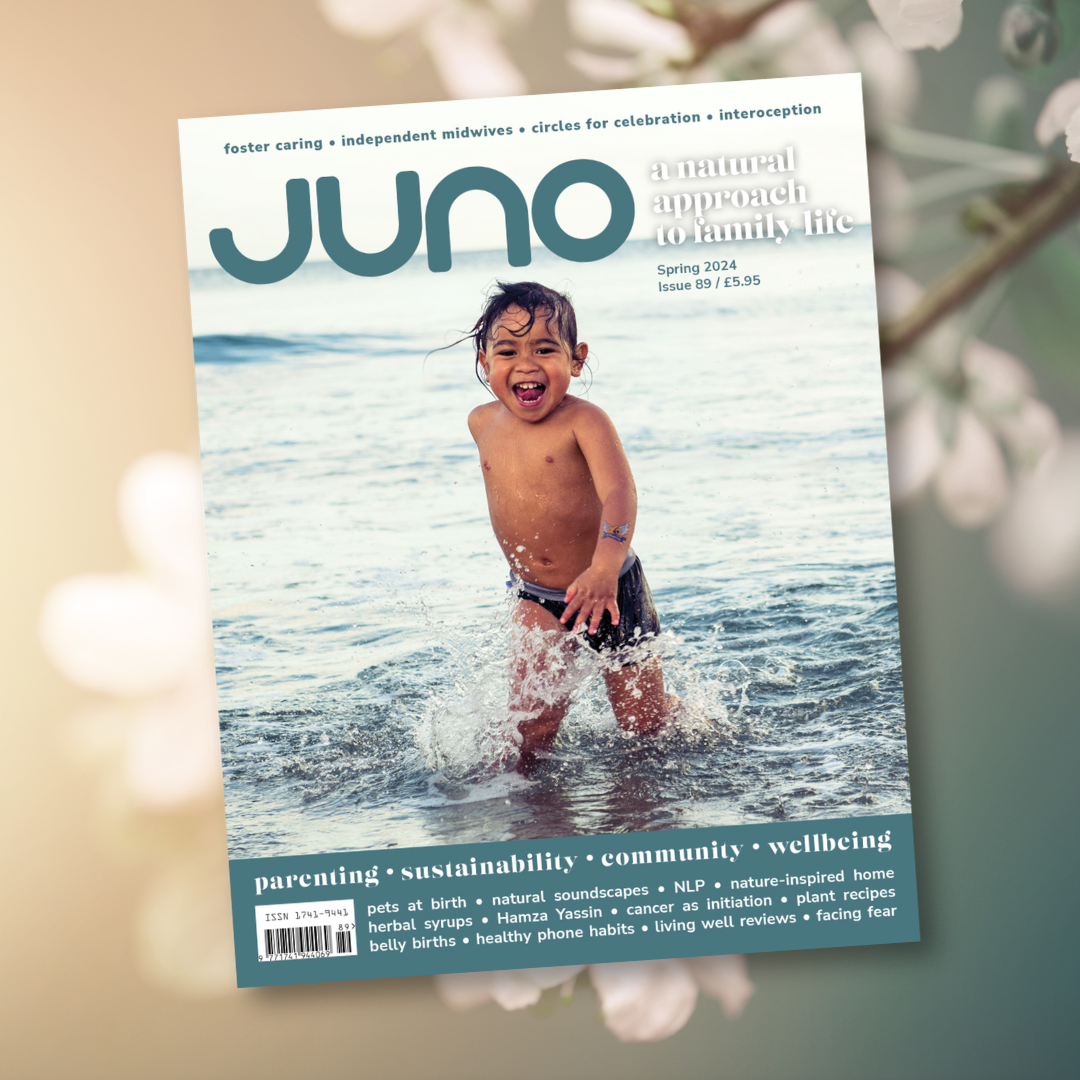Sometimes rediscovering the true roots of a festival can help remind us why we are celebrating, readjust our priorities and reconnect with the natural forces evident at a particular time of year. Christmas has been so seized upon as the primary festival we all celebrate in such a homogenous, material way that much of the magic of the season is lost. Rather than resenting the commercial influences which put boxes of Christmas biscuits on supermarkets shelves the day the school supplies come down in September, why not develop your own family traditions, reclaim the festival, and practice celebrating the aspects which really speak to you and your family?
If you can make the space and time and find the peace to cultivate the festivals of December with your family, the transition from the old year to the new can be one of restoration for your inner forces. Beginning with Advent and finishing with Twelfth Night, the whole month can be filled with gradual preparations, family celebrations and a period of winding down and reflection before the beginning of the New Year.
For thousands of years pre-Christian northern societies enlivened the dark days of mid-winter with celebrations of fire, light and jollity; these brought welcome relief from the cold, short days and hurried along the renewal of springtime. The Pagan tradition of burning fires to ward off dark spirits has long been incorporated into the Christian festival that we generally follow in modern times. It reflects our inner fires which burn brightly at this time of year, particularly children’s fiery enthusiasm for Christmas projects. Channelling children’s energies into craft projects and preparations can disperse the external pressures which would focus them on the frenzy of buying and ‘having’ which dominates at Christmas time. As the month of December unfolds, cold, wet afternoons spent indoors are a great time to keep small hands busy making presents and decorations, getting ready for the festive days ahead. Colourful wax paper stars on our windows ward off the dreary days outside even before we need mention the word Christmas; they can be made in many colours and sizes, but a basic eight-pointed star in any scale looks beautiful1.
The early part of December is dominated by the theme of preparation. Advent starts on the Sunday nearest to November 30th and begins as the cycle of the natural year comes to a close. We begin to look towards renewal. Many families share traditions of baking special biscuits during advent, either for sharing with friends or to use as decorations later in the month. An advent wreath can be made by tying fresh evergreen sprigs onto a wire ring with a moisture-retentive base like newspaper. Fix four candles onto the wreath and light another candle each Sunday before Christmas. This long festival can be helpful for children who are anticipating exciting days ahead. Similarly, advent calendars needn’t be a chocolate-a-day event. Try making an advent walnut chain filled with tiny treasures instead (read on to find out how to make one).
St Barbara’s day is celebrated on December 4th with branches being cut and brought into the house; with the right care and attention these can be coaxed into flowering on Christmas day and remind us of the spirit of renewal which will come with spring. Apple, plum, cherry or blackthorn branches can be cut on a long slant before being placed in water in a cool room for two or three days; then bring them into a warm room and slit the stems, placing them in lukewarm water. The buds will begin to swell; spray the branches with tepid water before the petals are visible and you should have an impressive display by the end of the month.
The traditional sign of nature’s ability to retain life in midwinter are the evergreens which we bring inside to decorate our houses. These are usually holly, ivy, bay and rosemary. Holly and ivy are particularly associated with pre-Christian fertility festivals at this time of year as they represent the male and female archetypes; bay and rosemary fill your home with delicious scents, when our senses are hungry for stimulation. At this time of year, when nature’s own picture is subdued and we are living mostly indoors, it can be of great excitement for children to bring the outdoors inside and fill your home with living greenery.
As the month progresses, the days grow darker and on December 21st we celebrate the winter solstice, the shortest day of the year. This celebration relates to many pagan northern hemisphere traditions. Saturnalia was the name the Romans gave to their holiday marking the winter solstice when they spent a week revelling from December 17th to 23rd. The ancient Norse festival of Yule also once fell on December 21st; fires were lit in honour of Thor and the yule log would be kept burning until the new year had begun. The yule log was adopted by Christians and traditionally burns for the twelve days of Christmas. Not many of us are lucky enough to have hearths big enough for such a log, but having a special candle lit at mealtimes for the twelve days can remind us we are still in the middle of important festivities, even after Christmas Day itself has passed.
The Norse god Thor also expressed the generous and creative social spirit of Christmas which we would recognise today. He was a genial, Santa Claus figure whom the Romans called Jove, from where we gain the word jovial. Keeping in mind these ancient figures can inspire us to celebrate the hearty good nature of giving at this time of year and remind us that our glass is half full; the shortest day may be upon us, but from now on the days begin to get longer again. It is easy to feel as if Christmas was only invented by modern commercial forces intent on draining our finances, but by recalling these ancient figures of generosity we can inject new vitality into our celebrations. It is no coincidence that Christmas Day, the festival of Christ’s birth, falls smack in the middle of the much older festivals. The first Christians incorporated Roman and Pagan festivals into their own. In 350, Pope Julius I declared that Christ’s birth would be celebrated on December 25. There is little doubt that he was trying to make it as painless as possible for pagan Romans (who remained a majority at that time) to convert to Christianity. The new religion went down a bit easier with new-believers, knowing that their feasts would not be taken away from them. After the revelry of the winter solstice and Christmas, a spirit of renewal is celebrated with the coming of the New Year. It has long been held that the moment of transition from an old year to a new could provide a moment for unwelcome beings from the ‘other world’ to intrude; traditionally we assert our human presence as strongly as possible with shouts, cheers and ringing bells. What better invitation to children than to make as much noise as they can. New Year’s Eve is full of possibility and excitement; an opportunity to leave behind the old and start afresh. We look backwards at the end of the year, reconcile ourselves with what has passed and feel hope and new resolve for the future. Rituals are held all over the world and it is considered an almost magical time. Try making walnut boats which float towards your New Year fortune2. Noisy games with family and friends are as appropriate at New Year as at any children’s birthday party with the bonus that there is no focus on one child; it’s a celebration for all, a chance to be together and wish one another well for the coming year. Finally we reach Epiphany or Twelfth Night at the beginning of January when tradition dictates we must take down all our Christmas decorations; perhaps an indication to move on with the work of the New Year. The Monday after Epiphany is named Plough Monday, and was the official start to the spring ploughing. Allowing ourselves the time after Christmas and New Year to continue to enjoy our decorations and the spirit of the season can bring us all, adults as well as children, back to earth gently, and a final emphasis on the work of the coming year is an inspiration rather than a disappointment at the end of a long festival.
Most of us will probably still give presents on Christmas Day and thoroughly enjoy seeing the delight they bring to little faces. But by spreading our celebrations throughout the month and engaging children in a gradual build-up to and come-down from Christmas Day itself we can feel a little less of the pressure and a little more of the good spirit and magic of this important time of year.
Make an Advent Walnut Chain
You will need
As many walnuts as there are days in advent
Gold paint
3-4 metres (yards) of red or blue ribbon 2cm (3/4") wide
Small presents to put in the nutshells
To make
Glue Open the nuts carefully so as not to crack or break the shells.
Remove the kernel. Keep the two halves of each nut together so that they don’t get muddled up.
Paint the outside of the nuts gold and leave them to dry. In one half of each nut place a small present such as a little bell, a dwarf, a shell, a little sheep, a hare of teased sheep’s wool, a little stone, a little lump of soft beeswax, a marble, a gold-foil star, a dried flower, a bead, and so on.
Apply a little glue to each half and stick them together with the ribbon running through the two halves.
During Advent a nut is cut off the ribbon each day and opened.
A game for the New Year
A game I played as a child represents the ‘clean slate’ we all have at the beginning of a new year and is great fun for children and adults. With all participants’ help, lay a cloth approximately 2m by 3m on the floor and carefully place upon it four or five shallow dishes filled with water and half a dozen uncooked eggs in their shells. All the players take a good look at the arrangement then all but one adult leaves the room. Outside the room, the first player is blindfolded and brought in again by the remaining adult; they are asked to navigate from one side of the cloth to the other, blindfolded and without stepping on an egg or in a dish of water. When they successfully reach the other side, the blindfold is removed for them to discover that they have shuffled slowly, tentatively across a completely blank cloth - while the blindfold was being put on, all the obstacles have been removed! As each new player comes in for her ordeal, those who have passed the test can watch, give ‘advice’ as players tiptoe through invisible obstacles and enjoy the spectacle!
____
Mel Tibbs lives in Dorset and is a full-time mother to Lucy and Ben.
Advent Walnut Chain is an extract from Crafts Through the Year by Thomas and Petra Berger, Floris Books.




